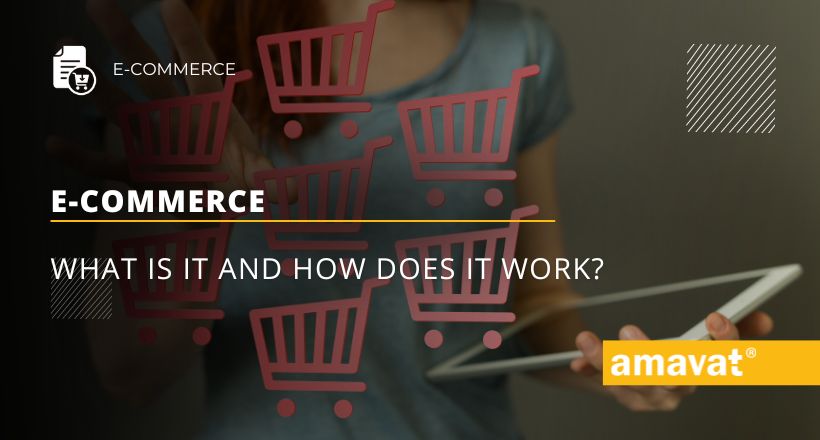E-commerce: What is it and how does it work?
E-commerce, also known as electronic commerce, refers to the buying and selling of goods and services over the internet. It covers a variety of commercial transactions that are carried out remotely, without the need for physical presence at traditional points of sale. Through e-commerce, customers can browse online store offerings from anywhere in the world, place orders, and make payments online, often in real-time.
In essence, e-commerce is a modern form of commerce that allows businesses to reach a broad audience without needing a physical store. The final delivery of products or services can take place either online or offline, depending on the nature of the transaction and the specifics of the goods offered.
How does e-commerce work?
The foundation of e-commerce is the internet, which allows users to access commercial platforms from anywhere in the world using computers, smartphones, and other devices. Customers visit online store websites, browse available products, and place orders, which are processed on servers. The order process includes selecting products, entering contact and shipping information, making a payment, and, in some cases, tracking the order status until it is fulfilled.
Advantages of e-commerce
One of the main advantages of online commerce is that there is no need to invest in physical retail spaces, which significantly reduces business costs. Online stores can operate 24/7, allowing customers to make purchases at any time, regardless of local business hours. Additionally, e-commerce enables sellers to quickly connect with customers, carry out promotional activities, and more easily attract new clients thanks to its global reach.
Moreover, e-commerce allows for bypassing intermediaries, which can reduce costs for consumers. Online stores also facilitate the use of advanced marketing strategies, such as cross-selling (selling complementary products) and up-selling (offering more expensive, advanced products).
Challenges in the e-commerce industry
While e-commerce offers many benefits, it also presents specific challenges. One of them is the low level of customer trust in purchasing expensive products online. Before making a final decision, consumers often conduct online research, check reviews, and compare prices, but may prefer to see the product in person at a physical store. Therefore, it is crucial for online sellers to ensure customers feel secure by providing detailed product descriptions, reviews, photos, and videos. This can increase consumer trust and their willingness to purchase expensive items online.
Another challenge is the return of clothing and footwear due to the inability to try them on before purchase. Many customers order clothes in several sizes and return those that do not fit, generating costs for sellers, both in logistics and in the resale of often discounted items. To minimize returns, it is important to provide the most accurate product information possible, which helps better manage customer expectations and reduces the risk of returns.
Finally, positioning an online store in search engines is a long-term process requiring specialized knowledge. It is worth considering working with experts or using popular sales platforms, such as Amazon, which already attract large numbers of customers every day.
Types of e-commerce
E-commerce can be divided into several types depending on which entities participate in transactions.
The most popular models are:
- B2B (business-to-business): Transactions between companies. An example could be platforms where businesses buy and sell products or services directly from each other.
- B2C (business-to-consumer): The most recognizable model, where companies sell goods or services directly to consumers. Examples of such platforms include Amazon and Allegro.
- C2C (consumer-to-consumer): A model in which consumers sell products or services to other consumers. Examples include auction sites like eBay or OLX.
- C2B (consumer-to-business): The reverse of the traditional B2C model, where consumers offer products or services, and businesses buy them. An example could be platforms where users sell photos or other digital content to companies.
E-commerce platforms
Various platforms are used for conducting online commerce. They can be divided into:
- SaaS subscription platforms (Software as a Service): Offered on a subscription model, where the user pays for using the platform, and the provider handles its maintenance and security.
- Open Source platforms: Software that can be downloaded, installed, and customized to individual needs. The store owner is responsible for its technical operation.
- Dedicated platforms: Created to order, tailored to the specific needs of a given store.
- Licensed platforms: Offering a wide range of functions, aimed primarily at larger, more developed online stores.
Why invest in e-commerce?
Online commerce opens up many opportunities for entrepreneurs. First, it allows businesses to reach a much larger number of customers than traditional, physical retail outlets. Online stores can operate 24/7, enabling sales even when brick-and-mortar locations are closed. Additionally, the costs of launching an online store are much lower than those of traditional businesses, which is a key factor for new entrepreneurs.
Thanks to the availability of analytical tools, online store owners can also track customer preferences and adjust their offerings to meet their needs, contributing to more effective marketing efforts.
In conclusion, e-commerce is a rapidly growing sector of the economy that is gaining importance thanks to the increasing number of internet users. It offers businesses the opportunity to grow in the global market and provides consumers with the convenience of shopping without leaving home.





